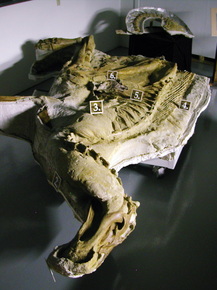What is a Cretaceous Science Investigation? Let's start with the word Cretaceous. If you know about dinosaurs, you have probably heard this word. The Cretaceous was a period of time when the dinosaurs lived. Scientist call the time between 145 million years ago and 65 million years ago the Cretaceous Period. It was during the Cretaceous Period, 77 million years ago, that the dinosaur mummy lived. And since we are learning about a scientific study of this part of the Cretaceous - it is a Cretaceous Science Investigation!
Guide to Dinosaur Mummy CSI

If you want to learn more about Dinosaur Mummy CSI and Leonardo, CLICK HERE
The dinosaur mummy is a Brachylophosaurus. This was a plant eating dinosaur that was a member of the hadrosaur family. Sometimes we call hadrosaurs "duck billed" dinosaurs because they had beaks that were flat and wide, sort of like a duck. To learn more about Brachylophosaurus, CLICK HERE
Teaching Tools for Parents and Teachers (Kids, too!)

The team at the Las Vegas Natural History Museum and Leonardo Project have created some fun activities and teaching materials that you can use in the family room or the classroom. Just CLICK HERE or on the picture on the right for some great entertaining and educational things to do!
How to Make a Dinosaur Mummy
To help understand how the Dinosaur Mummy, nicknamed Leonardo, was preserved, the science team brought in world-renowned mummy expert (the human kind of mummies) Dr. Arthur Aufderheide. He explained to the team how the dinosaur mummy may have been preserved naturally in a wet environment. Dr. Aufderheide suspects that a chemical called aldehyde soaked into the dinosaur's dead body. The chemical would have come from tree branches that fell into the water covering the body. Dr. Joe Skulan, who has been studying how large modern animals become mummified, describes how internal organs could be preserved in the fossilized mummy. In the video below, Dr. Aufderheide is the well-dressed gentleman, Dr. Skulan is in the brown shirt.
What the Dinosaur Mummy Revealed
It is easy to see why the dinosaur mummy is so special. To the average person, this is an amazing fossil that lets us learn things about dinosaurs that were not possible in the past. To scientists, however, Leonardo is truly the beginning of a new dinosaur renaissance. As Dr. Robert Bakker said so well when he first saw this incredible fossil, "Leonardo is so complete, he answers questions we never thought to ask."
The Dinosaur Mummy that Might Have Been Better
The video below tells the story of the SS Mount Temple, a ship that was sunk during World War I. This ship had a cargo of fossils that included what fossil hunter Charles Sternberg called the best dinosaur mummy he had found. The cargo now rests far under the ocean, so we may never know anything more about this and the other fossils lost.
Unique Ankylosaur Fossil
The video below is a lecture from the Royal Tyrrell Museum in Alberta, Canada. It describes a very unique fossil of an ankylosaur that was discovered in far northern Alberta. While not a dinosaur mummy like Leonardo, this fossil did reveal some very unique preservation and shows many features that are not usually seen on most dinosaur fossils. Scientists from the Royal Tyrrell participated in the study of the dinosaur mummy.
Dinosaur Guts, Prehistoric Plants and Fossil Poop

During the Cretaceous Science Investigation of the dinosaur mummy, there were nearly 100 scientists and researchers who helped uncover the secrets of the fossil. Two of those scientists were Dr. Karen Chin and her student, Justin Tweet. Dr. Chin is known as Dr. Poop to many kids as her field of scientific study is dinosaur coprolites - fossil poop! However, the research Justin and Dr. Chin, along with Dr. Dave Eberth, did on the dinosaur mummy was very important and led to some amazing discoveries. To learn about what they found, CLICK HERE
The Man Who Discovered the Age of the Earth

Sometimes we need to remember that a lot of what we learn had to be discovered by someone. For example, we know that water boils at at 212 degrees Fahrenheit (100 degrees Celsius), but do you ever think that someone had to figure that out? When we talk about dinosaurs and geology, we have to talk about the age of the Earth. Scientists know how old it is now - over 4 billion years - but it took a lot of work to figure that out. This story, written by British scientist Dr. Cherry Lewis, tells the story of several men over more than two centuries who struggled to understand the age of our planet. CLICK HERE for the story.

